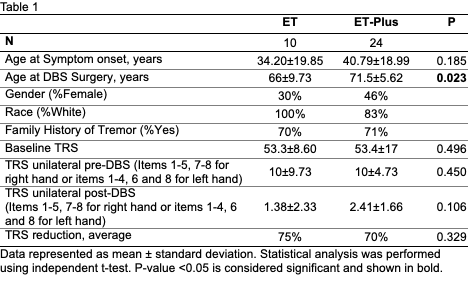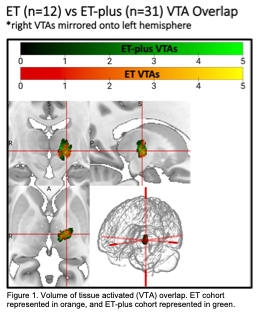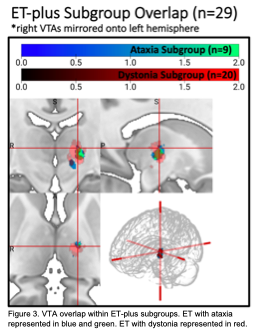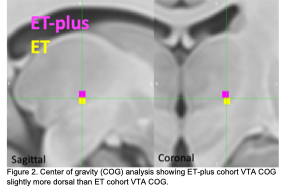Category: Tremor
Objective: To examine differences in structural connectivity of deep brain stimulation (DBS) sites in patients with essential tremor (ET) and essential tremor plus syndrome (ET-plus).
Background: Although ET is a phenomenologically heterogeneous condition1, thalamic DBS appears to be equally effective for all subtypes described2,3. We hypothesized that the effective stimulation site within the ventral thalamus may differ between subtypes. Furthermore, we hypothesized that connections from the stimulation site of ET subtypes would also differ. By capturing differences in connectivity to the optimal stimulation site in ET subtypes, we sought to determine whether these subtypes are pathophysiologically distinct from ET.
Method: A retrospective chart review was conducted on all ET patients undergoing VIM DBS at MUSC between 01/2012 and 02/2022. Clinical, demographic, neuroimaging, and DBS stimulation parameter data were collected. Clinical characteristics and pre-DBS videos were reviewed to divide ET and ET-plus cohorts. Patients in ET-plus cohorts were further divided into ET with dystonia, ET with ataxia, and ET with other. DBS leads were reconstructed using Lead-DBS and connectivity of the volume of tissue activated (VTA) was performed using normative connectomes. Tremor improvement was measured by reduction in tremor rating scale (TRS) post-DBS.
Results: Sixty-nine ET patients were reviewed, and 10 ET and 24 ET-plus patients were included in the final analyses. ET group had an earlier age at onset (P = 0.18) and underwent DBS surgery at a younger age (P = 0.023). Both groups achieved effective tremor control. (Table 1). No significant differences were found in lead placement or VTA connectivity, however, the VTA center of gravity (COG) in the ET-plus cohort was located slightly dorsal to the VTA COG in the ET cohort (Figures 1-2). No significant group differences were found in VTA overlap with the dentato-rubral-thalamic (DRTT) tracts or the ansa lenticularis. Dystonia was the most common feature in the ET-plus subgroups. In a subgroup analysis, the dystonia subgroup had a slightly more medial COG compared to the ataxia subgroup (Figure 3).
Conclusion: VIM DBS therapy is efficacious in patients with ET and ET-plus. There was no significant differences in optimal stimulation site or structural connectivity between ET, ET-plus and ET-plus subgroups.
References: 1. Consensus Statement on the Classification of Tremors. From the Task Force on Tremor of the International Parkinson and Movement Disorder Society – PMC. Accessed March 10, 2023. https://www.ncbi.nlm.nih.gov/pmc/articles/PMC6530552/
2. Steffen JK, Jergas H, Petry-Schmelzer JN, et al. Thalamic Deep Brain Stimulation in Essential Tremor Plus Is as Effective as in Essential Tremor. Brain Sciences. 2020;10(12):970. doi:10.3390/brainsci10120970
3. Tsuboi T, Wong JK, Eisinger RS, et al. Comparative connectivity correlates of dystonic and essential tremor deep brain stimulation. Brain. 2021;144(6):1774-1786. doi:10.1093/brain/awab074
To cite this abstract in AMA style:
C. Yu, D. Lench, G. Revuelta. Comparing the Connectivity of Thalamic Deep Brain Stimulation Sites in ET and ET Plus Syndrome [abstract]. Mov Disord. 2023; 38 (suppl 1). https://www.mdsabstracts.org/abstract/comparing-the-connectivity-of-thalamic-deep-brain-stimulation-sites-in-et-and-et-plus-syndrome/. Accessed November 26, 2025.« Back to 2023 International Congress
MDS Abstracts - https://www.mdsabstracts.org/abstract/comparing-the-connectivity-of-thalamic-deep-brain-stimulation-sites-in-et-and-et-plus-syndrome/




